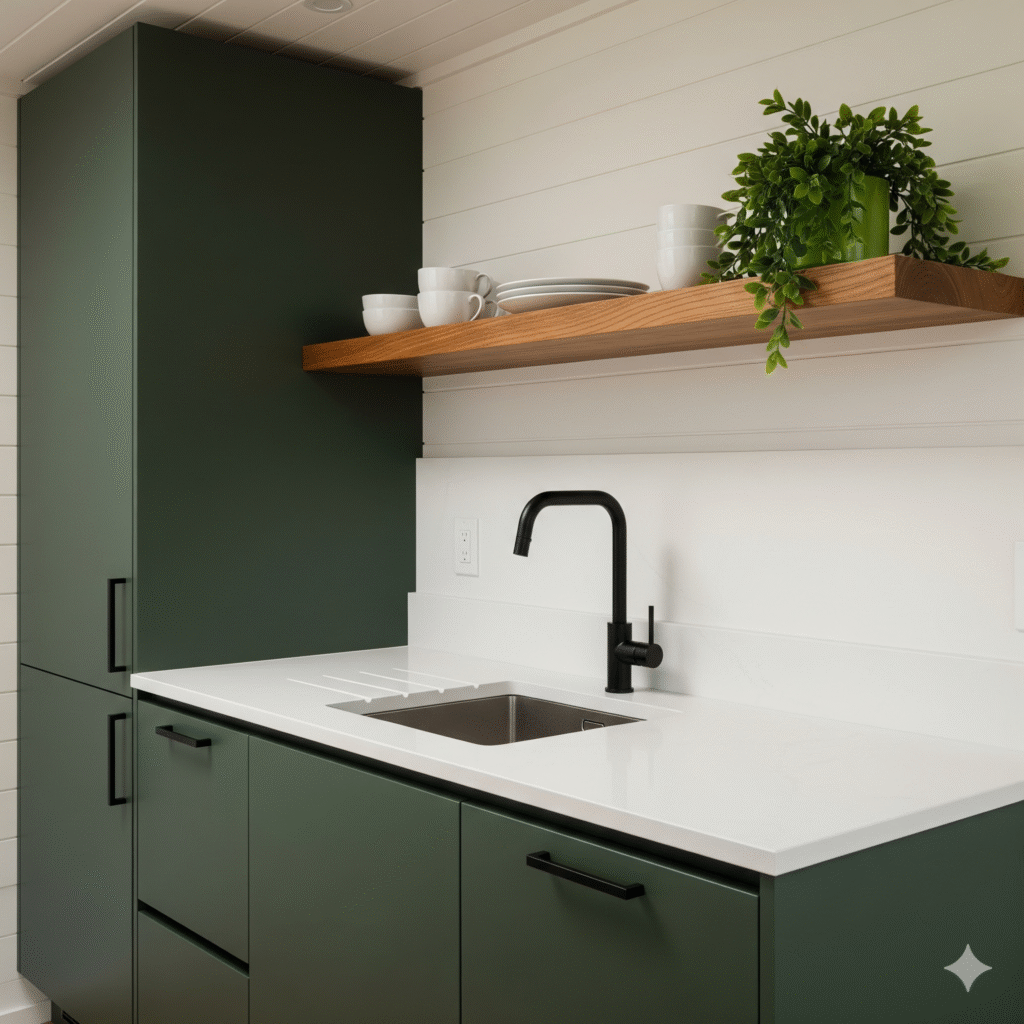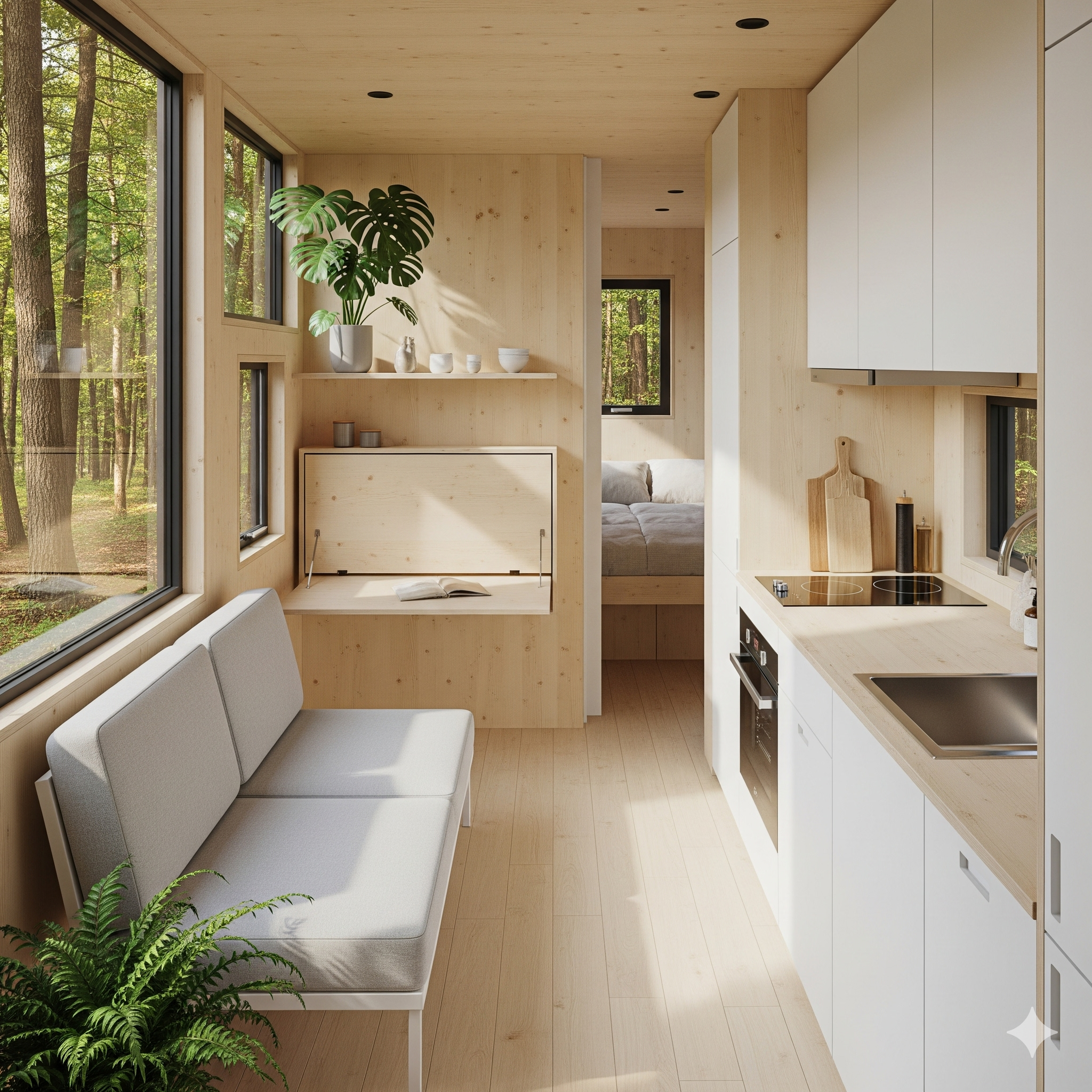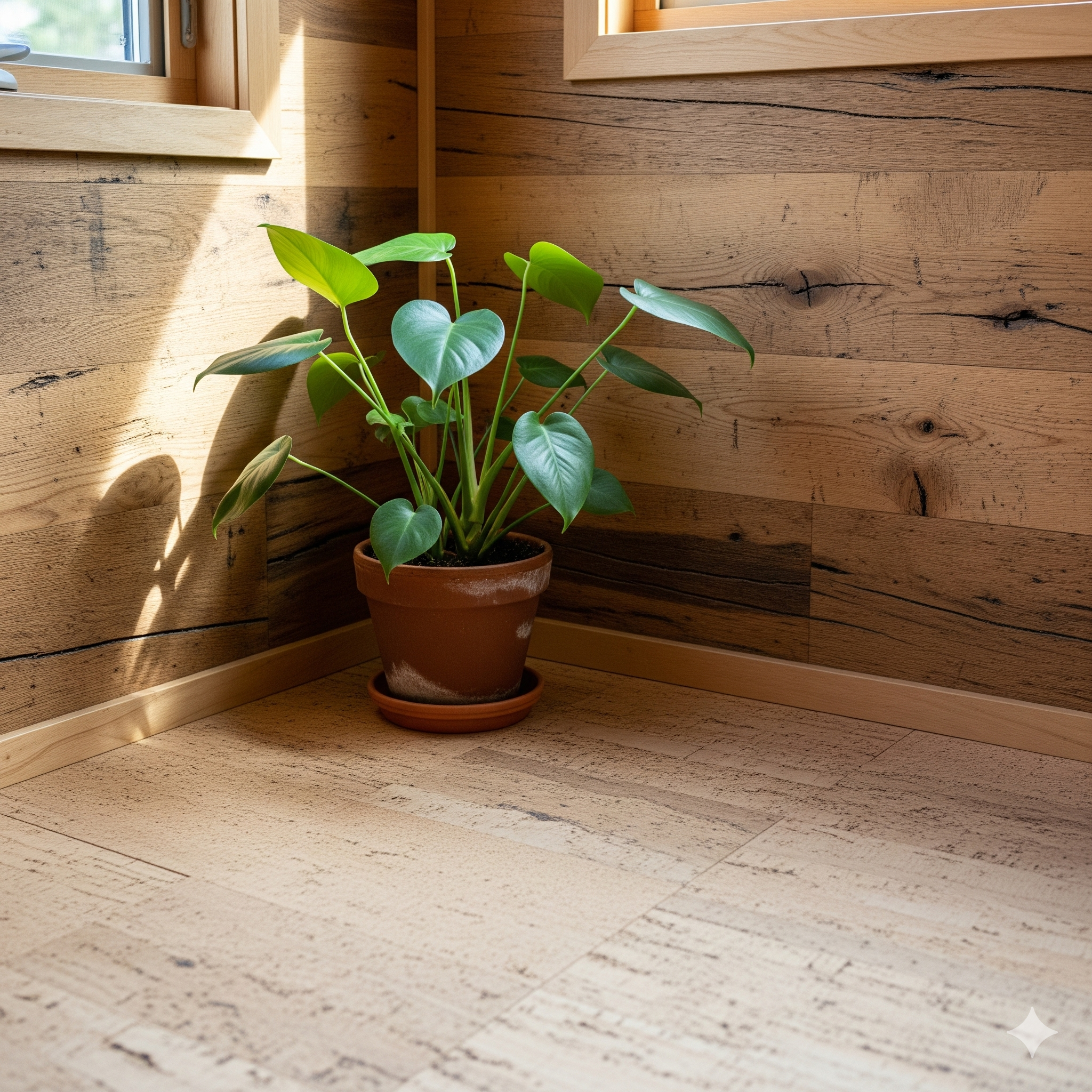Tiny Home Interior: 5 Modern Design Trends
Discover the top modern design ideas for your tiny home interior. Our 2025 trend guide explores multi-functional furniture, smart tech, and natural materials.
Beyond Minimalism: The Top Trends for a Modern Tiny Home Interior
For years, the conversation around tiny living has been synonymous with rustic cabins and extreme, bare-bones minimalism. But a new era of design has arrived. The modern tiny home interior of 2025 is not about deprivation; it’s about intelligent, sophisticated design that blends cutting-edge technology with natural warmth and multi-functionality. It’s about creating a space that is not only compact but also beautiful, comfortable, and seamlessly integrated with your lifestyle. It’s a design philosophy that proves small spaces can be showcases of high style and innovation.
Here at NeatTinyHome.com, we are passionate about the evolution of small-space living. This guide will explore the most exciting and impactful trends shaping the future of tiny homes. We’ll move beyond the obvious and dive into the specific modern design ideas that make a compact home feel expansive, luxurious, and deeply personal. From furniture that transforms to walls that connect you with nature, get ready to be inspired. Whether you are planning a build or looking to update your current space, these trends will help you craft a tiny home interior that is truly ahead of the curve.
Multi-Functional by Design, Not by Accident
The cornerstone of any modern tiny home interior is the concept of multi-functionality. However, the current trend moves away from clunky, convertible furniture and towards elegant, integrated solutions that are built into the home’s architecture. Think less of a standalone folding table and more of a kitchen island that contains a hidden slide-out dining table. From my experience in designing these spaces, the goal is to have furniture that serves two or three purposes without ever looking like it’s a compromise. This includes platform beds on hydraulic lifts that reveal massive storage underneath, staircases where each step is a deep drawer, and sleek Murphy beds that fold away to reveal a fully functional home office desk. Companies like Resource Furniture are pioneers in this space, showcasing high-end transformative pieces that are perfect inspiration. This approach ensures that every square foot is working its hardest, providing maximum utility while maintaining a clean, uncluttered aesthetic—a hallmark of contemporary modern design ideas.
The Power of Light and Natural Materials
Modern design has always revered natural light, but in a tiny home, it’s a non-negotiable element. The latest trends push this concept to the max with expansive glass walls, large picture windows, and oversized skylights that flood the space with daylight. High-quality window manufacturers like Marvin offer stunning, large-format options that can effectively make a wall disappear. This not only reduces the need for artificial lighting but also makes a small interior feel boundless by blurring the line between inside and out. This connection to the outdoors is further enhanced by a strong emphasis on natural and sustainable materials. The current aesthetic favors light-colored woods like birch, maple, and ash for floors, walls, and built-in furniture. Using eco-friendly options like sustainable cork flooring, available from retailers like Green Building Supply, adds warmth, comfort, and a green credential to your home. These are often paired with honest, tactile materials like concrete countertops, slate flooring in a bathroom, or a leather pull on a cabinet door. This focus on authentic, natural materials creates a tiny home interior that feels calming, warm, and deeply rooted in its environment.
Bringing the Outdoors In: Biophilic Design
Going a step beyond just using natural materials, biophilic design is a trend that actively seeks to connect us with nature within our homes. This philosophy, elegantly explored in publications like Architectural Digest, posits that we have an innate desire to be close to nature, and incorporating it into our living spaces can reduce stress and improve well-being. In a modern tiny home interior, this manifests in several ways, from creating dedicated nooks for indoor plants to designing a layout around a primary view. The table below offers a simple guide to integrating these principles.
| Biophilic Element | Example in a Tiny Home | Benefit |
|---|---|---|
| Plants & Greenery | Integrated planter boxes, a small living wall, or hanging plants. | Improves air quality, reduces stress. |
| Natural Textures | Unfinished wood accents, a slate entryway, linen curtains. | Creates a calming, tactile experience. |
| Views of Nature | A large window perfectly framing a tree, lake, or garden. | Enhances tranquility and focus. |
Seamless Smart Technology Integration
A truly modern tiny home interior is a smart one. The latest trend is to integrate technology in a way that is almost invisible, adding functionality without adding visual clutter. This means hidden speakers embedded in the ceiling, smart lighting systems, and thermostats that learn your habits to conserve energy. For example, a system like Philips Hue allows for complete control over the color and intensity of your lighting from a simple app, dramatically changing the mood of a room without any extra hardware. This also includes clever uses of space, like a projector screen that retracts into the ceiling, eliminating the need for a bulky TV, or charging stations built directly into nightstands and kitchen counters. These thoughtful modern design ideas ensure that the home is not just a passive shelter but an active partner in a more efficient and convenient life, all while maintaining a minimalist aesthetic.
Final Thoughts: A Smarter, More Stylish Small Space
The modern tiny home interior is a beautiful testament to the power of good design. It proves that you don’t need a sprawling floor plan to live a life of comfort, style, and connection. By embracing multi-functionality, natural light, sustainable materials, and seamless technology, you can create a small home that feels expansive, luxurious, and perfectly attuned to the future of living. It’s a space that is not defined by its limitations, but by its endless possibilities.
What’s Your Modern Must-Have?
Which of these modern design ideas excites you the most? Is it the built-in transforming furniture or the connection to nature? Let us know what your dream tiny home interior would include in the comments below!
Frequently Asked Questions
What colors make a tiny home look modern?
While light and neutral colors like warm whites, soft grays, and light woods are foundational, a modern look is often achieved with bold, high-contrast accents. Think black window frames, a dark-colored feature wall, or a pop of saturated color (like deep green or navy blue) in the kitchen cabinetry against a neutral backdrop.
How do I add texture to a modern tiny home without it looking cluttered?
Focus on tactile materials within the architecture itself. A slatted wood feature wall, a concrete countertop, or a tile backsplash with a unique finish adds texture without adding “stuff.” For decor, choose a few high-quality pieces with texture, like a chunky knit throw blanket, a linen pillow, or a single ceramic vase.
Is minimalism still a trend in tiny homes?
Yes, but it has evolved. Instead of stark, empty spaces, the trend is now “warm minimalism” or “functional minimalism.” This means the space is still uncluttered, but it feels warm and inviting through the use of natural materials, soft textures, and personally meaningful decor. Every item has a purpose, but the overall feeling is cozy, not cold.





Post Comment